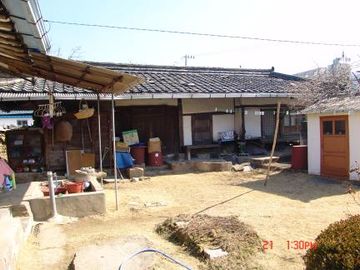"청도 이호우와 이영도 생가"의 두 판 사이의 차이
(→영문) |
(→영문) |
||
| 35번째 줄: | 35번째 줄: | ||
This house was built in 1910 and is the birthplace of the famous ''sijo'' poets Yi Ho-u (1912-1970) and Yi Yeong-do (1916-1976), who were also siblings. | This house was built in 1910 and is the birthplace of the famous ''sijo'' poets Yi Ho-u (1912-1970) and Yi Yeong-do (1916-1976), who were also siblings. | ||
| − | ''Sijo''* is a Korean traditional poetic form that emerged near the end of the Goryeo period (918-1392) and flourished throughout the Joseon period (1392-1910). ''Sijo'' | + | ''Sijo''* is a Korean traditional poetic form that emerged near the end of the Goryeo period (918-1392) and flourished throughout the Joseon period (1392-1910). ''Sijo'' comprise of three lines of 14-16 syllables each, for a total of 44-46 syllables and often explore romantic, metaphysical, or spiritual themes. |
Yi Ho-u started his literary career in 1939. He is known to have successfully transformed classical ''sijo'' to reflect the emotions and worldview of contemporary people. His younger sister Yi Yeong-do started writing in 1945. She is famous for her distinctive and elegant representation of emotions unique to Koreans. | Yi Ho-u started his literary career in 1939. He is known to have successfully transformed classical ''sijo'' to reflect the emotions and worldview of contemporary people. His younger sister Yi Yeong-do started writing in 1945. She is famous for her distinctive and elegant representation of emotions unique to Koreans. | ||
2020년 10월 25일 (일) 22:28 판
| 청도 이호우와 이영도 생가 Birthplace of Yi Ho-u and Yi Yeong-do, Cheongdo |
|
 청도 이호우와 이영도 생가, 국가문화유산포털, 문화재청. |
|
| 대표명칭 | 청도 이호우와 이영도 생가 |
|---|---|
| 영문명칭 | Birthplace of Yi Ho-u and Yi Yeong-do, Cheongdo |
| 한자 | 淸道 李鎬雨와 李永道 生家 |
| 주소 | 경북 청도군 청도읍 유천길 46, 259-28, 259-33, 259-24 (내호리) |
| 지정번호 | 국가등록문화재 제293호 |
| 지정일 | 2006년 12월 4일 |
| 분류 | 등록문화재/기타/인물기념시설 |
| 시대 | 일제강점기 |
| 수량/면적 | 2동, 1층, 안채 90.9㎡, 사랑채 85.3㎡ |
| 웹사이트 | 청도 이호우와 이영도 생가, 국가문화유산포털, 문화재청. |
|
|
|
해설문
국문
이 집은 1910년경에 지어진 근대 한옥으로, 오누이 시조 시인으로 유명한 이호우(李鎬雨, 1912~1970)와 이영도(李永道, 1916~1976)가 태어나고 자란 곳이다.
오빠인 이호우는 1939년 『동아일보』에 <낙엽>을 발표하면서 창작 활동을 시작했으며, 대표작으로 <개화>, <살구꽃 피는 마을>, <휴화산>, <달밤> 등이 있다. 이 작품들은 고전적 시조를 현대의 감각과 정서로 전환시켰다는 평가를 받는다.
여동생인 이영도는 1945년 대구의 문예지 『죽순』에 <제야>를 발표하면서 창작 활동을 시작했다. <보릿고개>, <달무리> 등 민족 고유의 정한을 섬세하고 단아한 가락에 담아냈다.
이 집은 사랑채와 안채가 마당을 사이에 두고 서로 직교하는 ㄱ자형으로 되어 있다. 사랑채는 정면 5칸, 측면 1칸으로 사랑마루, 사랑방, 작은 사랑방, 고방으로 이루어져 있다. 안채는 정면 4칸, 측면 1칸 반으로 왼쪽부터 안방, 대청, 작은방, 부엌으로 이루어져 있다.
영문
Birthplace of Yi Ho-u and Yi Yeong-do, Cheongdo
This house was built in 1910 and is the birthplace of the famous sijo poets Yi Ho-u (1912-1970) and Yi Yeong-do (1916-1976), who were also siblings.
Sijo* is a Korean traditional poetic form that emerged near the end of the Goryeo period (918-1392) and flourished throughout the Joseon period (1392-1910). Sijo comprise of three lines of 14-16 syllables each, for a total of 44-46 syllables and often explore romantic, metaphysical, or spiritual themes.
Yi Ho-u started his literary career in 1939. He is known to have successfully transformed classical sijo to reflect the emotions and worldview of contemporary people. His younger sister Yi Yeong-do started writing in 1945. She is famous for her distinctive and elegant representation of emotions unique to Koreans.
This house consists of a men’s quarters and women’s quarters which together form an L-shaped layout with a courtyard in the middle. The men’s quarters features a wooden front porch, main room, secondary room, and a storeroom. The women’s quarters comprises of a main room, a wooden-floored hall, secondary room, and a kitchen.
- I guess there has to be some explanation of what sijo is.
영문 해설 내용
1910년경에 지어진 이 집은, 오누이 시조시인으로 유명한 이호우(1912-1970)와 이영도(1916-1976)가 태어나고 자란 곳이다.
이호우는 1939년에 등단하였으며, 고전 시조를 현대적인 감각과 정서로 전환시켰다는 평가를 받는다. 이호우의 여동생인 이영도는 1945년에 창작활동을 시작했다. 한국 민족 고유의 정한을 섬세하고 단아한 가락에 담아냈다.
이 집은 사랑채와 안채가 마당을 사이에 두고 서로 직교하는 ㄱ자형으로 배치되어 있다. 사랑채에는 사랑마루, 사랑방, 작은 사랑방, 고방이 있으며, 안채에는 왼쪽으로부터 안방, 대청, 작은방, 부엌이 있다.
참고자료
- 청도 이호우와 이영도 생가, 『디지털청도문화대전』
- 이호우, 이영도, 『디지털청도문화대전』
- 이호우, 이영도, 『한국민족문화대백과사전』